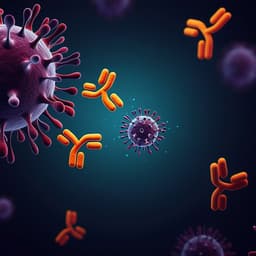
Medicine and Health
Severe T cell hyporeactivity in ventilated COVID-19 patients correlates with prolonged virus persistence and poor outcomes
K. Renner, T. Schiwitty, et al.
This study unveils critical insights into T cell hyporeactivity in hospitalized COVID-19 patients, especially those on ventilation. The research highlights how prolonged viral persistence leads to adverse outcomes, but also showcases the potential for recovery. Conducted by a team of experts, this work emphasizes the importance of identifying patients who could benefit from T cell interventions.
~3 min • Beginner • English
Introduction
SARS-CoV-2 emerged in late 2019 and causes a spectrum of disease from asymptomatic infection to severe pneumonia requiring intensive care and mechanical ventilation. Severe outcomes are associated with risk factors such as advanced age, male sex, obesity, pulmonary disease and diabetes, and with hyperinflammation and microthrombosis. Monocytes/macrophages contribute to pathogenesis, yet effective viral clearance requires adaptive immunity with virus-specific T and B cell responses. However, the nature of polyclonal T cell reactivity in COVID-19 remains unclear, with conflicting reports of insufficient or excessive responses using conventional PBMC-based assays. This study aimed to sensitively assess polyclonal T cell reactivity by measuring downstream effects on responder cells directly in whole blood, to determine whether T cell dysregulation correlates with disease severity, viral persistence and outcomes, to explore underlying mechanisms (intrinsic versus extrinsic), and to develop a predictive score for mortality in ventilated patients.
Literature Review
Prior studies identified clinical risk factors for severe COVID-19 and implicated hyperinflammation and coagulation abnormalities in poor outcomes. Innate immunity alone appears insufficient to clear infection; most patients develop SARS-CoV-2-specific T and B cell responses, and virus-specific T cell responses correlate with viral clearance. Dexamethasone benefits suggest hyperinflammation contributes to pathology, while also potentially affecting T cell survival. Polyclonal T cell reactivity data are inconsistent: PBMC-based stimulation showed unchanged or decreased IFN-γ or variable cytokine responses in severe disease, whereas SARS-CoV-2-specific T cell responses are often reduced in critically ill and older patients and linked to unfavorable outcomes. These mixed findings highlight limitations of classical PBMC assays and motivate alternative, more sensitive approaches to gauge T cell functional capacity in vivo.
Methodology
Study design and subjects: 55 adult COVID-19 patients (RT-PCR positive) and 42 adult healthy controls were enrolled at University Hospital Regensburg (Germany) from March–July 2020 with ethics approval and informed consent. Patients were stratified as non-ventilated or ventilated (ICU), with ventilated patients further categorized as survived (discharged from ICU) or died in ICU. Multiple longitudinal samples were obtained for many patients.
Whole blood activation assay: T cells were polyclonally activated by culturing diluted heparinized whole blood in tubes pre-coated with immobilized anti-CD3 antibodies (typically 5–10 μg/ml) for 24 h at 37 °C, 5% CO₂. T cell activation was quantified indirectly via downstream changes on responder cells by flow cytometry, including: basophils (e.g., CD131 downregulation), plasmacytoid dendritic cells (pDCs), CD14+ monocytes (e.g., CD123 modulation, CD169/Siglec-1), and neutrophils (e.g., CD11b upregulation). Values were analyzed as ratios of expression with versus without anti-CD3 stimulation. Absolute counts and MFI were also recorded for fresh immunophenotyping.
Plasma transfer experiments: To test whether T cell functional impairment was T cell-intrinsic or extrinsic, healthy donor whole blood was washed to remove plasma, then supplemented with heat-inactivated plasma from healthy controls, non-ventilated, or ventilated COVID-19 patients and stimulated with anti-CD3. Downstream responder cell marker changes were compared across plasma sources. Clinical steroid use was annotated; no other immunosuppressants were used in these patients.
Cytokine modulation and rescue: Recombinant cytokines (e.g., IL-2), blockade of IL-10 with neutralizing antibody, and supplementation with L-tryptophan (to counteract IDO-mediated depletion) were tested for their ability to restore T cell-driven downstream effects in whole blood. A broad panel of cytokines (GM-CSF, IL-3, IL-4, IL-5, IL-6, IL-15, IFN-γ, TNF-α) was available for stimulation or measurement, with concentrations typically around 20 ng/ml. ELISAs measured cytokines in supernatants.
PBMC assays: Purified PBMCs (via Ficoll) were stimulated with soluble anti-CD3 (clone OKT3, 5 μg/ml) for 24 h. Classical T cell activation readouts (CD25, CD71, cytokine release) and downstream effects on co-present monocytes/basophils (limited in PBMC-only context) were assessed, to compare sensitivity versus whole-blood assays.
Flow cytometry and immunophenotyping: Multicolor panels included markers for T cells, basophils, pDCs, monocyte subsets (CD14+ classical and CD16+), and neutrophils, with gating strategies provided in supplementary materials. Fresh blood immunophenotyping quantified absolute cell counts and basal activation marker MFIs (e.g., neutrophil CD11b, monocyte CD169) across groups.
Predictive score development: Three parameters were selected for mortality risk in ventilated patients based on discriminatory power: anti-CD3–induced upregulation of CD123 on monocytes (<130% considered weak), anti-CD3–induced upregulation of CD11b on neutrophils (<130% considered weak), and absolute basophil count in peripheral blood (<25/µL considered low). Logical AND combinations of parameters were tested, and sensitivity, specificity, NPV, and PPV were calculated on a dataset of 77 complete ventilated-patient samples (8 deceased, 69 survived).
Key Findings
- Whole-blood downstream readouts reveal pronounced T cell hyporeactivity in COVID-19 patients, detectable even in non-ventilated patients and markedly worse in mechanically ventilated patients.
- Clinical demographics: ventilated patients were more often male (80% vs 52% in non-ventilated) and had significantly longer viral persistence (mean 28 vs 10 days from symptom onset to last positive RT-PCR). Ventilated patients displayed higher inflammatory and coagulation biomarkers (CRP, IL-6, D-dimer) and markers of organ dysfunction (LDH, bilirubin, CK). Among ventilated, deceased patients showed higher leukocyte counts and inflammation/liver dysfunction markers than survivors.
- Plasma transfer experiments demonstrate a T cell-extrinsic mechanism: plasma from COVID-19 patients, especially from ventilated patients, suppressed anti-CD3–induced downstream responses in healthy washed whole blood (reduced basophil CD131 downregulation, reduced monocyte CD123 upregulation, reduced neutrophil CD11b upregulation), independent of steroid treatment.
- Rescue strategies: Exogenous IL-2 improved T cell reactivity particularly in non-ventilated patients; blockade of IL-10 and L-tryptophan supplementation (counteracting IDO activity) showed beneficial effects on T cell-driven downstream responses.
- PBMC-based assays were less sensitive and yielded inconsistent differences between patient groups, highlighting the advantage of whole-blood responder-cell readouts for detecting functional T cell impairment.
- Longitudinally, T cell hyporeactivity was reversible: patients who were weaned from ventilation showed improving downstream responses before and after weaning, whereas patients with fatal outcomes had persistent, near-complete hyporeactivity over days.
- Fresh blood immunophenotyping: ventilated patients (especially those who died) had lower basophil counts; pDCs were decreased in ventilated patients; monocyte CD169 (Siglec-1), a type I IFN-inducible marker, was elevated in non-ventilated patients but returned toward baseline in ventilated patients, suggesting impaired type I IFN responses in critical illness. Neutrophil CD11b expression followed a similar pattern, being higher in non-ventilated and reduced in ventilated/deceased patients. CD16+ monocytes were decreased in patients, while classical CD14+ monocytes were relatively preserved.
- Sex differences: monocyte responses to T cell activation (e.g., CD123 modulation) were stronger in males than females among healthy and non-ventilated groups, aligning with higher proinflammatory cytokines reported in males.
- Predictive score for mortality in ventilated patients: combining three parameters—weak anti-CD3–induced upregulation of monocyte CD123 (<130%), weak anti-CD3–induced upregulation of neutrophil CD11b (<130%), and low basophil count (<25/µL)—achieved sensitivity 75%, specificity 100%, NPV 94%, and PPV 100% for predicting death in the stimulated dataset (77 complete ventilated-patient samples: 8 deceased, 69 survived). Other two-parameter combinations showed slightly lower performance.
Discussion
This study addresses conflicting reports on T cell functionality in COVID-19 by leveraging a sensitive, physiology-adjacent whole-blood assay that reads T cell activation through multifaceted downstream effects on basophils, pDCs, monocytes, and neutrophils. The data reveal that polyclonal T cell hyporeactivity is a prominent feature of hospitalized patients and tracks with disease severity, prolonged viral persistence, and clinical outcomes. The hyporeactivity is largely driven by extrinsic plasma factors rather than intrinsic T cell defects, as shown by suppression of responder-cell activation in healthy blood exposed to patient plasma. Potential mediators include elevated IL-10 and tryptophan depletion via IDO, supported by partial restoration with IL-10 blockade and L-tryptophan. The whole-blood approach proved more sensitive and consistent than PBMC-based readouts, likely because it preserves cellular interactions and captures a broad spectrum of T cell-derived signals. Fresh immunophenotyping corroborated systemic immune dysregulation in severe disease, including reductions in basophils and pDCs and diminished type I IFN signatures (monocyte CD169) in ventilated patients, consistent with impaired antiviral responses. The observed male–female differences in monocyte responsiveness to T cell activation may contribute to sex-based disparities in inflammatory milieu and outcomes. Finally, a simple, implementable three-parameter score derived from these functional assays effectively identified ventilated patients at high risk of death, suggesting clinical utility for risk stratification and for selecting patients who might benefit from strategies aimed at restoring T cell function.
Conclusion
The study introduces a sensitive whole-blood assay that detects polyclonal T cell hyporeactivity in COVID-19, particularly in mechanically ventilated patients, and links this dysfunction to prolonged viral persistence and poor outcomes. The hyporeactivity is mediated by plasma factors and is, in many cases, reversible with clinical improvement. Immunophenotyping highlights diminished type I IFN signatures and reductions in key innate cell subsets in severe disease. A three-component score (weak monocyte CD123 and neutrophil CD11b upregulation after anti-CD3, plus low basophil count) accurately predicts mortality risk among ventilated patients. These findings support clinical strategies to restore T cell functionality (e.g., IL-2 support, IL-10 blockade, addressing tryptophan metabolism) and warrant validation of the predictive score in larger, multicenter cohorts. Future work should identify specific plasma mediators of suppression, refine therapeutic interventions to reverse hyporeactivity safely, and evaluate the score prospectively for clinical decision-making.
Limitations
- Single-center study with a modest sample size (55 COVID-19 patients, 42 controls), which may limit generalizability.
- The predictive score was developed and assessed on a limited dataset of ventilated patients and requires validation in larger, independent cohorts.
- Observational design with potential confounders (e.g., variable timing of sampling, steroid use in a subset) despite analyses suggesting steroid-independent effects.
- The exact plasma mediators responsible for T cell hyporeactivity were not fully identified; suggested mechanisms (e.g., IL-10, IDO/tryptophan depletion) need mechanistic confirmation.
- PBMC-based assays showed limited sensitivity; while the whole-blood approach is more physiologic, it may be influenced by variations in blood cell composition and handling across centers.
Related Publications
Explore these studies to deepen your understanding of the subject.







